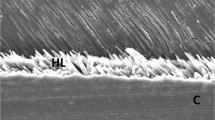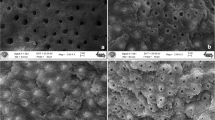Abstract
The goal of this study was to show the modifications in the ultrastructure of the dentin surface morphology following different surface treatments. The stability of the adhesive compound with dentin after laser preparation compared with conventional preparation using different bonding agents was evaluated. An Er,Cr:YSGG laser and 36% phosphoric acid in combination with various bonding systems were used. A total of 100 caries-free human third molars were used in this study. Immediately after surgical removal teeth were cut using a band saw and 1-mm thick dentin slices were created starting at a distance of 4 mm from the cusp plane to ensure complete removal of the enamel. The discs were polished with silicon carbide paper into rectangular shapes to a size of 6 × 4 mm (±0,2 mm).The discs as well as the remaining teeth stumps were stored in 0.9% NaCl at room temperature. The specimens were divided into three main groups (group I laser group, group II etch group, group III laser and etch group) and each group was subdivided into three subgroups which were allocated to the different bonding systems (subgroup A Excite, subgroup B Scotchbond, subgroup C Syntac). Each disc and the corresponding tooth stump were treated in the same way. After preparation the bonding composite material was applied according to the manufacturers’ guidelines in a hollow tube of 2 mm diameter to the disc as well as to the corresponding tooth stump. Shear bond strength testing and environmental scanning electron microscopy were used to assess the morphology and stability of the resin–dentin interface. The self-etching bonding system showed the highest and the most constant shear values in all three main groups, thus enabling etching with phosphoric acid after laser preparation to be avoided. Thus we conclude that laser preparation creates a surface texture that allows prediction of the quality of the restoration without the risk of negative influences during the following treatment steps. This can easily and repeatedly be achieved.










Similar content being viewed by others
References
Davidson CL (1996) Principles of adhesion. In: Dondi dall' Orologio G, Fuzzi M, Prati C (eds) Adhesion in restorative Dentistry. Tipolitografia Valbonesi, Forli, Italy, pp 1–4
Van Meerbeek B, Inokoshi S, Braem M, Lambrechts P, Vanherle G (1992) Morphological aspects of the resin-dentin interdiffusion zone with different adhesive systems. J Dent Res 71(8):1530–1540
Pashley DH, Tao I, Boyd I, King GE (1988) Scanning electron microscopy of the substructure of smear layer in human dentin. Arch Oral Biol 33(4):265–270
Nakabayashi N, Kojima K, Masuhara E (1982) The promotion of adhesion by infiltration of monomers into tooth substrates. J Biomed Mater Res 16(3):265–273
Nakabayashi N (1992) Adhesive bonding with 4-META. Oper Dent 5:125–130
Carvalho RM, Yoshiyama M, Pashley EL, Pashley DH (1996) In vitro study of the dimensional changes in dentin after demineralization. Arch Oral Biol 41(4):369–377
Erickson RL, Glasspoole EA (1994) Bonding in tooth structure: a comparison of glass-ionomer and composite-resin systems. J Esthet Dent 6(5):227–244
Hibst R, Keller U (1989) Experimental studies of the application of the Er:YAG laser on dental hard substances: I. Measurement of the ablation rate. Lasers Surg Med 9(4):338–344
Keller U, Hibst R (1989) Experimental studies of the application of Er:YAG laser on dental hard substances: II. Light microscopic and SEM investigation. Lasers Surg Med 9(4):345–351
Takizawa M, Aoki S, Takase Y, Ishikawa I, Kumazaki M, Inoue M, Zennyu K, Fujii B, Hasegawa K, Ishikawa I (1995) Clinical evaluation of Er.YAG laser for cavity preparation. Jpn J Conserv Dent 38:1035–1047
Keller U, Hibst R, Geurtsen W, Schilke R, Heidemann D, Klaiber B, Raab WH (1998) Erbium:YAG laser application in caries therapy. Evaluation of patient perception and acceptance. J Dent 26(8):649–656
Keller U, Hibst R (1997) Effects of Er:YAG laser in caries treatment: a clinical pilot study. Lasers Surg Med 20(1):32–38
Stock K, Hibst R, Kellern U (1997) Comparison of Er:YAG and Er:YSGG ablation of dental hard tissues. Medical Applications of Lasers in Dermatology, Ophthalmology, Dentistry and Endoscopy. Proc SPIE 3192:88–95
Harashima T, Kinoshita J, Kimura Y, Brugnera A, Zanin F, Pecora JD, Matsumoto K (2005) Morphological comparative study on ablation of dental hard tissues at cavity preparation by Er:YAG and Er,Cr:YSGG lasers. Photomed Laser Surg 23(1):52–5
Aoki A, Ishikawa I, Yamada T, Otsuki M, Watanabe H, Tagami J, Ando Y, Yamamoto H (1998) Comparison between Er:YAG laser and conventional technique for root caries treatment in vitro. J Dent Res 77:1404–1414
Visuri SR, Gilbert JL, Wright DD, Wigdor HA, Walsh JT Jr (1996) Shear strength of composite bonded to Er:YAG laser-prepared dentin. Dent Res 75(1):599–605
Schoop U, Kluger W, Moritz A, Nedjelik N, Georgopoulos A, Sperr W (2004) Bacterial effect of different laser systems in deep layers of dentin. Lasers Surg Med 35(2):111–116
Niu W, Eto J, Kimura Y, Takeda FH, Matsumoto K (1998) A study of microleakage after resin filling of class V cavities prepared by Er:YAG laser. J Clin Laser Med Surg 16(4):227–231
Bertrand M, Hessleyer D, Muller-Bolla M, Nammour S, Rocca J (2004) Scanning electron microscopic evaluation of resin-dentin interface after Er:YAG laser preparation. Lasers Surg Med 35(1):51–57
Buoncorre MG (1955) A simple method of increasing the adhesion of acrylic materials to enamel surfaces. J Dent Res 34:849–853
Nakabayashi N, Nakamura M, Yasuda N (1991) Hybrid-layer as a dentin bonding mechanism. J Esthet Dent 3(4):133–138
Van Meerbeeek B, Munck JD, Mattar D, Landuyt KV, Lambrechts P (2003) Microtensile bond strengths of an etch & rinse and self-etch adhesive to enamel and dentin as a function of surface treatment. Oper Dent 28:647–660
Kameyama A, Kawada E, Takizawa M, Oda Y, Hirai Y (2000) Influence of different acid conditioners on the tensile bond strength of 4-META/MMA-TBB resin to Er:YAG laser irradiated bovine dentin. J Adhes Dent 2:297–304
Martinez-Insua A, Da Silva DL, Rivera FG, Santana-Penin UA (2000) Differences in bonding to acid-etched or Er:YAG-lased-treated enamel and dentin surfaces. J Prosthet Dent 84:280–288
Matos AB, Palma RG, Saraceni CH, Matson E (1997) Effects of acid etching on dentin surface: SEM morphological study. Braz Dent J 8(1):35–41
Carvalho RM, Ciucchi B, Sang H, Yoshiyama M, Pashley DH (1999) Resin diffusion through demineralised dentin matrix. Rev Odontol Univ Säo Paulo 13:417–424
Tay FR, Gwinnet AJ, Wei SH (1998) Micromorphological spectrum of acid conditioned dentin following the application of water-based adhesives. Dent Mater 14(5):329–338
Sano H, Takatsu T, Ciucchi B, Horner JA, Matthews WG, Pashley DH (1995) Nanoleakage: leakage within the hybrid layer. Oper Dent 20:18–25
Watanabe L, Nakabayashi N, Pashley DH (1994) Bonding to ground dentin using a self-etching Phenyl-P primer. J Dent Res 73:1212–1220
Summitt JB, Robbins WJ, Hilton TJ (eds) (2006) Fundamentals of Operative Dentistry, 3rd edn. Quintessence, Hanover Park, p 227
Lee BS, Lin PY, Chen MH, Hsieh TT, Lin CP, Lai JY, Lan WH (2006) Tensile bond strength of Er,Cr:YSGG laser irradiated human dentin and analysis of resin-dentin interface. Dent Mater 23:570–578
Sung EC, Chenard T, Caputo AA, Amodeo M, Chung EM (2005) Composite resin bond strength to primary dentin prepared with Er,Cr:YSGG laser. J Clin Pediatr Dent 30:45–49
Gorucu J, Gurgan S, Cakir FY, Bicer CO, Gorucu H (2011) The effect of different preparation and etching procedures on the microleakage of direct composite veneer restorations. Photomed Laser Surg 29(3):205–211
Türkmen C, Sazak-Oveçoğlu H, Günday M, Güngör G, Durkan M, Oksüz M (2010) Shear bond strength of composite bonded with three adhesives to Er,Cr:YSGG laser-prepared enamel. Quintessence Int 41(6):e119–e124
Conflicts of interest
All authors state that they have no conflicts of interest.
Author information
Authors and Affiliations
Corresponding author
Rights and permissions
About this article
Cite this article
Beer, F., Buchmair, A., Körpert, W. et al. Morphology of resin–dentin interfaces after Er,Cr:YSGG laser and acid etching preparation and application of different bonding systems. Lasers Med Sci 27, 835–841 (2012). https://doi.org/10.1007/s10103-011-0979-x
Received:
Accepted:
Published:
Issue Date:
DOI: https://doi.org/10.1007/s10103-011-0979-x




